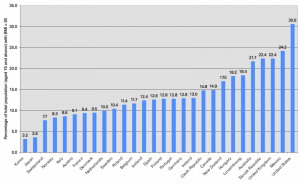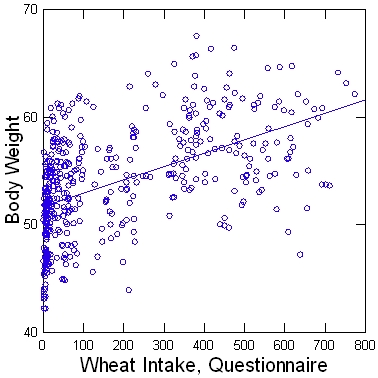There seems to be more soul-searching in the medical profession lately. A few pieces caught my eye.
The Money Scramble Corrupts Diagnosis
First, an editorial in the British Medical Journal begins:
Who decides what constitutes a disease and what is normality? Over the centuries such decisions have been the preserve of the medical profession, aided more recently by modern medical science. But the profession has grown too close to those who profit from developing drugs for new diseases and is no longer fit to make these decisions. [1]
The idea is that researchers, doctors, and drug companies are highly motivated to expand the medical industry by inventing new “diseases” that provide new scope for drug treatment.
The recent suggestion that statins be distributed over the counter at McDonald’s restaurants is one example of such a push. The editorial cites new diagnostic categories created by drug-company affiliated scientist-doctors:
[P]rehypertension [is] a condition that along with preosteoporosis and prediabetes has the potential to transform most of the world’s adult population into patients….
Of the US guideline committee that first created the diagnostic category of prehypertension in 2003, 11 of 12 members eventually declared multiple ties to industry. [1]
These “pre-diseases” could be given a more accurate name: “wheat and vegetable oil consumption syndrome.”
Another example of an emerging disease is sarcopenia, or muscle weakness in the elderly. The New York Times reports:
[G]eriatric specialists, in particular, are now trying to establish the age-related loss of muscles as a medical condition under the name sarcopenia, from the Greek for loss of flesh. Simply put, sarcopenia is to muscle what osteoporosis is to bone.
“In the future, sarcopenia will be known as much as osteoporosis is now,” said Dr. Bruno Vellas, president of the International Association of Gerontology and Geriatrics. [2]
FuturePundit comments: “[B]y all means, label every change we experience while aging as a vile disease. How about hair graying and hair loss? Surely diseases…. Don’t feel as flexible as you used to? That’s a disease. Don’t have the energy of a 17 year old? Disease, horrible malady. Needs a cure. Finding yourself needing reading glasses in your early 40s? Don’t kid yourself. That’s a disease. Demand a cure. Stem cells, gene therapy, nano repair bots, whatever it takes.”
Has the Medical Industry Become Parasitic Upon Its Patients?
Somehow or other, we have developed a government-industry-medical complex that extracts tremendous amounts of money from taxpayers and patients, but damages health. Subsidies for wheat and soybeans and corn make toxic foods cheap; junk science like the “lipid hypothesis” promotes their consumption; elite doctors appointed supreme authorities by government bureaucrats declare biomarkers of wheat, corn, and soybean oil consumption to be diseases requiring drug treatment; the drug industry sells tens of billions of dollars of drugs to the afflicted persons.
Qui bono? Elites do well – elite doctors on the review and funding panels, bureaucrats, politicians, and pharmaceutical companies. Public health suffers.
Bureaucratization of Medicine
Bruce Charlton, the former editor of Medical Hypotheses, argues that medical research has been failing at its mission of making health improving advances in knowledge:
When people are asked about the success of modernity, they usually refer first to medicine….
I have even heard the whole thing boiled down to immunization and antibiotics, or to ‘anaesthesia’ – the existence of which are said to justify modernity against history; as in ‘how would you like to live in a world without ‘*’….
I have previously written about the failure of medical progress from the mid-twentieth century, and that for half a century we have been living through a medical research bubble –
http://qjmed.oxfordjournals.org/cgi/content/full/98/1/53
Yet the failure of medical research, defined as above, is stark: in broad terms we have not discovered any new classes either of antibiotics or pain killers for many decades. [3]
Medical research is very focused on incremental progress in an established research paradigm. Since many established research paradigms are mis-conceived – are cul-de-sacs that lead nowhere – incremental progress down these blind alleys translates into “no progress.”
When stuck in a cul-de-sac, one should reverse course and try some new direction. But medicine is increasingly unable to do this, Dr. Charlton says, due to the bureaucratization of medicine, and consequent stifling of independent creative research:
The reason we have failed to sustain medical progress are doubtless manyfold, but in essence I think it is because modernity has chosen bureaucratic expansion above creative individual discovery.
http://medicalhypotheses.blogspot.com/2010/04/cancer-of-bureaucracy.html
We prefer process over results – consequently we have a truly massive and expanding medical research process with zero or negative results. [3]
Nothing stifles creativity like a monopoly. Concentration of decision-making power in a few hands gives those hands an overwhelming incentive to obstruct change: for innovation could undermine the established social structure and deprive the decision-makers of power, income, wealth, and status. There is no surer way to achieve stagnation than a centralization of funding and decision authority.
As power has spread from individual doctors and researchers to distant bureaucracies, the medical profession has been demoralized:
As I look around medicine it is my impression that doctors know less, can do less, have less spirit, less sense of vocation (or none at all), are less able, make fewer breakthroughs, suffer greater losses of knowledge, have poorer judgment, do worse science, are less honest and have more wrong ideas than they did a generation ago. [3]
Conclusion
I have previously argued that we need a democratization of biomedical funding. Each taxpayer should be able to donate, say, $300 to the research of his or her choice. Projects seeking funding should be displayed on a public web site. This would force scientists to serve real people with real (or anticipated) health problems. This would create competition for public trust, and reward creative approaches to successful healing. No longer would the “old boy network” or peer-review clique control everything; a researcher would need only “1000 true fans”.
Doctors need more freedom to follow their clinical judgment. Let patients, not juries or medical boards, review doctors’ competence. Fear of loss of career and income – of sanctions from juries or medical boards – prevents doctors from prescribing unconventional treatments and engaging with their patients in the cooperative clinical experimentation that in the past led to so many breakthroughs.
Dispersal of power would have major benefits: increases in conversation, and of knowledge. Needing to find true fans, scientists would engage the public in conversation. Provided with funding power, fans would be motivated to learn how to use that power.
The medical profession is suffering from institutional centralization and stifling of individuals by elite authorities. It needs a healthy dose of creative destruction.
References
[1] Fiona Godlee, “Are we at risk of being at risk?” BMJ 2010; 341:c4766. http://www.bmj.com/content/341/bmj.c4766.full.
[2] Andrew Pollack, “Doctors Seek Way to Treat Muscle Loss,” New York Times, August 30, 2010, http://www.nytimes.com/2010/08/31/health/research/31muscle.html.
[3] Bruce Charlton, “The decline of medicine refutes modernity,” http://charltonteaching.blogspot.com/2010/09/decline-of-medicine-refutes-modernity.html.













Recent Comments